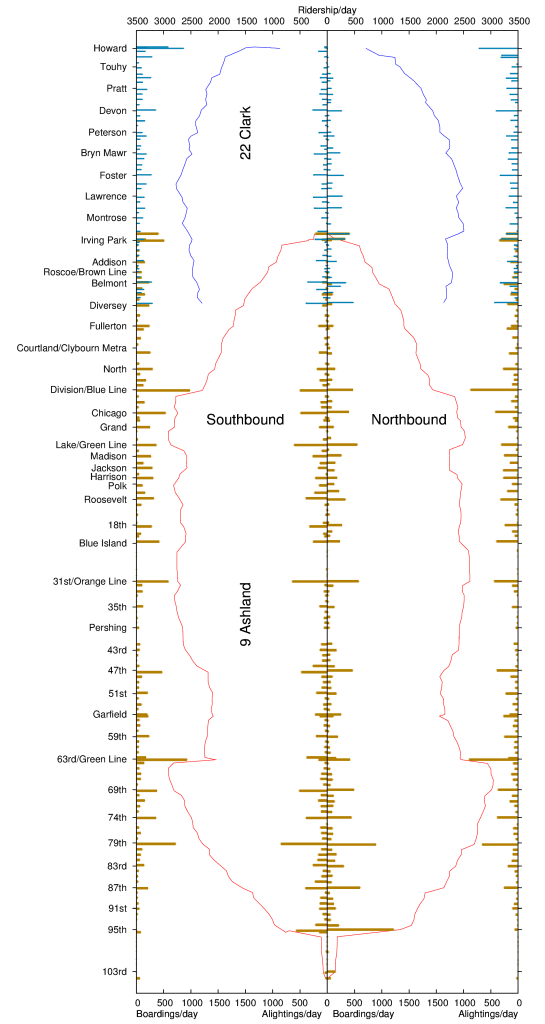The Ashland BRT proposal promises to provide service with similar speed and frequency of a new ‘L’ line across the heart of the city. This project would dramatically improve travel for tens of thousands of existing and potential customers. The proposed reallocation of street space to transit has received vocal opposition from businesses, a strong admonishment of the project’s Environmental Assesment from a former CDOT engineer and tepid political support. This series of posts will examine the case for BRT with some details not in the EA, potential design decisions to be made, and examinations of the concerns raised in Mr. Kaeser’s letter. Other criticisms from the Western-Ashland coalition have been well rebutted elsewhere.

To start, here is a plot of weekday ridership on the 9 Ashland and the portion of the 22 Clark bus north of Roscoe averaged over the month of September 2010. The plot is based on Automatic Passenger Count data that tracks the number of passengers boarding and alighting the bus as each stop in the CTA system. The data is compiled on a stop by stop basis. As several stops on Ashland are shared with multiple bus routes, an estimated number of boardings and alightings onto other routes was subtracted. Several similar plots have been produced by the Seattle Transit Blog for bus routes in that city.
The bars on the plot show the average weekday boardings and alightings at each stop while the lines show the number of passengers departing from (SB) or approaching (NB) the stop from the south. Unlike the plots for Seattle, there is no partitioning of the data into time or day and total ridership is measured instead of the number of passengers per bus. Ticks on the vertical axis show proposed stop locations for the BRT route, and additional major cross streets at 103rd and north of Irving Park.
A number of observations can be made from this plot, from north to south:
1. Ridership on the 22 Clark and 9 Ashland are well matched. Should BRT be extended north of Irving Park, no buses should be expected to turn back. About a sixth of existing customers on the 22 connect southbound on the Ashland bus at Irving Park. However, about half of the riders are riding to Wrigleyville and Lincoln Park north of Diversey and may be inconvenienced by a new forced transfer.
2. There are no strong ridership anchors on the existing 9 Ashland north of the Division/Blue Line stop.
3. While most ‘L’ stations provide a large number of passengers connecting to the Ashland bus, very few customers connect from the Brown Line. The connection requires an 800ft walk.
4. About half of the passengers south of 63rd are disembarking at the Green Line.
5. South of 63rd, ridership at local stops is much higher than it is at local stops on the North Side.
From these observations a couple of conclusions can be made.
a) Ashland BRT will attract significantly ridership above its existing ridership. Customers are disembarking off the existing service at 63rd to connect to a not very frequent Green Line. Customers are not using the existing service at all to get to the Brown Line. Ashland BRT would attract many existing customers by provide faster travel than the ‘L’. To take full advantage, the connection to the Paulina Brown Line stop will have to be improved, either by terminating to route at Lincoln and Roscoe, or by constructing a new station house facing Ashland.
b) Ridership at local stops on the south side is much higher than on the north side. Thus, it makes sense to provide service to local bus stops on the south side, especially south of 63rd. The south side local stop service can be provided by either BRT with 1/4 mile stop spacing or an overlaid local service.
c) Continuing both the BRT and 22 services at full frequency to Howard would be duplicative given the existing ridership. As most present customers on the 22 at Irving Park are traveling to locations along the 22 route, thus keeping the existing service pattern seems appropriate. However, improved service on Ashland may fundamentally change ridership patterns so that extending BRT to Andersonville or Howard and discontinuing the 22 at either Irving Park or Foster makes more sense. This decision would have to await observations from earlier phases of BRT implementation.
My next post in this series will examine existing bus speed, reliability, and sources of delay on Ashland using bus tracker and traffic tracker data. A third post will construct an Origin/Destination (OD) matrix from the ridership data in order to estimate how many customers would use the BRT service and how much of their time would be saved under various service patterns.
